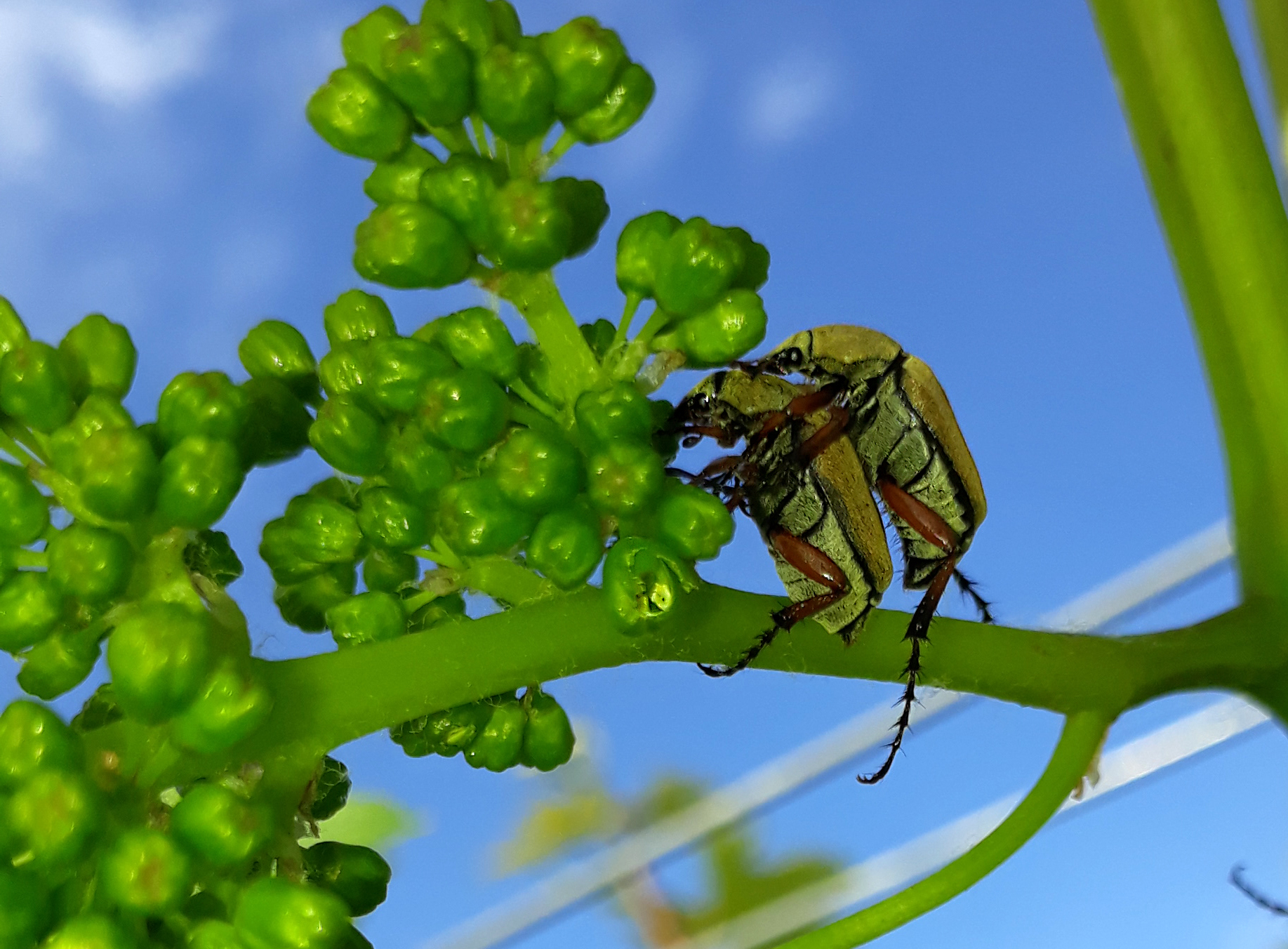Rose chafer management for northwest vineyards
Michigan's small fruit crops can be affected by the rose chafer beetles because adults can eat plant tissue in massive amounts.

Grape, blueberry, raspberry, blackberry and strawberry plants can have their leaves, flowers or buds damaged by feeding rose chafers (Photo 1). The rose chafer beetle is potentially damaging to Michigan’s small fruit crops because adults can eat large amounts of plant tissue. This light tan beetle with a darker brown head and long legs emerges during June and has recently been seen feeding in most small fruit and tree fruit crops. Sightings of these insects have increased in the past weeks throughout the fruit growing regions of Michigan, and growers should be vigilant if they have crops on sandy soils, where this pest is usually more of a problem.
Life cycle
Female beetles lay groups of eggs just below the surface in grassy areas of sandy, well-drained soils. Rose chafer larvae (grubs) spend the winter underground and move up in the soil to pupate in the spring. A few weeks later they emerge from the soil and disperse by flying. There is one generation per year, and this beetle is only found throughout the Eastern United States.
Male beetles are attracted to females and they congregate on plants to mate and feed. Feeding can continue for three weeks, though the earliest part of the emergence is most damaging because grapevines have relatively few leaves, and other small fruits may be close to harvest, restricting the control options for growers who need to be harvesting fruit.
Trapping
Rose chafer populations vary from year to year and are patchy within farms, so monitoring for beetles can enable growers and gardeners to identify bad years or hotspots before making control decisions. Beetles can be monitored using traps specifically designed for this insect. The traps are available from Great Lakes IPM of Vestaburg, Michigan. These are a modified form of the yellow trap for Japanese beetle but have a different floral lure and are white, which is more attractive to the insect.
Traps placed near a vineyard or field can be used to monitor the first emergence of the pest to serve as a warning of further emergence and to enable accurate spray timings. An alternative use of the trap is to place a large number of them inside or around the crop to attract beetles as they emerge and to trap them out of the crop. This mass trapping approach still needs some development for fruit crops because there is discussion about whether this approach attracts more beetles from the surrounding area into the crop.
Non-chemical controls
If there are only a few beetles in a backyard or plantation setting, or if the beetles appear in a small area of a crop, hand-picking can be an effective control. There are also reports that a cheesecloth fence placed around the plants and higher than the plants can deter the beetles because they seldom fly over the fence. The barrier can be removed after beetle feeding ends.
Biocontrol agents can play some role in reducing the number of larvae surviving through development in the soil, and shield bugs have been observed feeding directly on rose chafer adults. However, the rapid emergence of adults in the spring makes natural control of rose chafer adults uneconomical as a control option.
Chemical control
Most crops can withstand some loss of leaf area from rose chafer feeding. However, plants should be monitored regularly early in the season in case the number of rose chafers increases quickly. Young plants have difficulty withstanding feeding by beetles than older ones because of their small leaf area and developing root systems. In severe infestations, feeding on blossom buds of grapes (Photo 2) can result in severe crop loss. Under these conditions, applying insecticide are warranted to retain the crop and prevent excessive loss of leaf area.

Insecticides applied for control of other pests around the time of rose chafer activity are usually sufficient to achieve control. However, if the insecticide residue has a short period of activity, growers may lose effectiveness during the period of beetle feeding. In our research, we have found excellent control of rose chafer in grapes using Assail. There are many other insecticides listed for control of this pest in Michigan State University Extension bulletin E-154, “Michigan Fruit Pest Management Guide.”
Pyrethroids have a comparatively short residual period of activity, and repetitive application of insecticides from this is discouraged because of the effects on beneficial insects. Read the label carefully before targeting insecticides against this insect because rose chafer is not on the label of many insecticides registered for use in grapes.



 Print
Print Email
Email